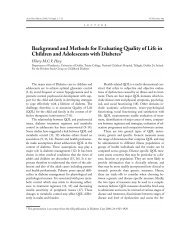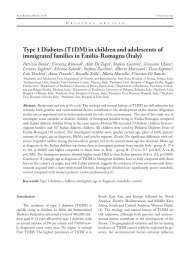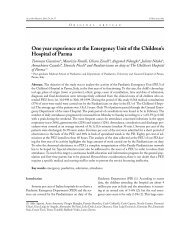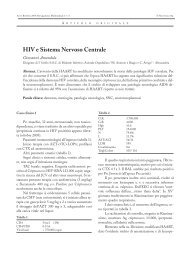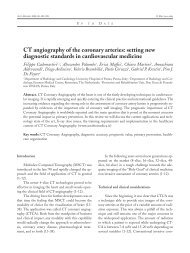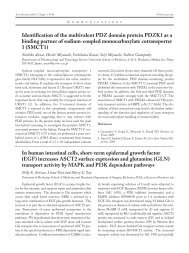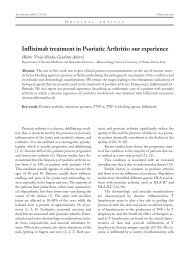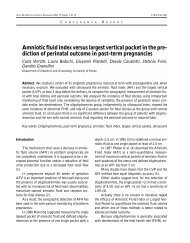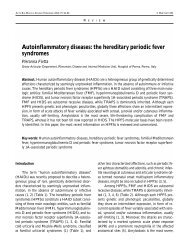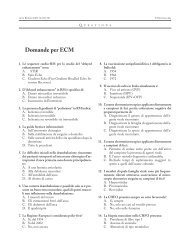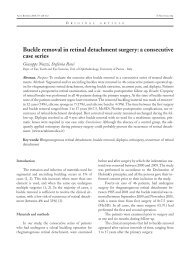Short reports+frontesp96-98 - Acta Bio Medica Atenei Parmensis
Short reports+frontesp96-98 - Acta Bio Medica Atenei Parmensis
Short reports+frontesp96-98 - Acta Bio Medica Atenei Parmensis
Create successful ePaper yourself
Turn your PDF publications into a flip-book with our unique Google optimized e-Paper software.
<strong>Short</strong> Reports<br />
119<br />
and younger (control) undergone an haemorrhoidectomy<br />
with stapler. Materials and methods: Between May<br />
2001 and December 2004 120 patients, of whom<br />
22.5% of 65 years older (bound included), underwent<br />
haemorrhoidectomy with stapler. Briefly description<br />
follows: 1st group; 51.85% of males and 48.15% of females;<br />
ASA scale evaluation results 63% ASA II and<br />
37% ASA I; 3.7% cases of II degree haemorrhoids with<br />
prolapse, 51.85% of III e 44.45% of IV; 3.7% underwent<br />
general anesthesia, 7.4% sacral one 4.8% subarachnoides<br />
one plus sedative, 74.1% subarachnoides<br />
one. 2nd group 65 years younger; 61.3% of males and<br />
38.7% of female; 2.14% ASA III, 17.2% ASA II and<br />
80.66% ASA I; 9.2% cases of II degree haemorrhoids<br />
with prolapse, 64.4% of III and 26.4% of IV; 6.42% underwent<br />
general anesthesia, 1.07% sacral one, 35.31%<br />
subarachnoides one plus sedative, 57.2% subarachnoides<br />
one. Results: In 96% of the cases the procedure was<br />
one-day surgery with 1.11 hospitalisation days for 1st<br />
group while 1.15 days for 2nd; operation average time<br />
28.7’ and 29.33’ in 1st group e 2nd respectively; 2.84<br />
hemostasis stitches for 1st group, 3 for 2nd. Immediate<br />
complication was post operative bleeding, needed<br />
surgical hemostasis or blood transfusion, observed in 9<br />
cases of whom 2 in 1st group and 7 in 2nd. Post operative<br />
delayed complications were: 1 cases of ragade bleeding,<br />
1 cases of stenosys anal canal and 1 case of persistent<br />
anal pain, discovered at all into 2nd group. 1st<br />
group patients average satisfaction 9.55, while 2nd 8.9.<br />
Discussion: In 1st group presentation symptoms were<br />
51.85% bleeding, 18.51% pain, 3.7% itch; in 2nd group<br />
were 58.06% bleeding, 44.08% pain, 1.07% itch. Postoperative<br />
symptoms in 1st group were 7.4% incontinence,<br />
7.4% tenesmus, 7.4% sense of incomplete evacuation<br />
while in 2nd group were 4.3% discomfort,<br />
2.15% constipation, 3.22% soiling and 1.07% tenesmus.<br />
You can say haemorrhoidal disease has different<br />
presentation and post-operative symptoms between<br />
two groups. Seems to be no difference between surgical<br />
procedure about performance time P=0.78 and hemostasis<br />
stitches P=0.36. Also patients post-operative<br />
judgement has no significative difference P=0.33. Conclusions:<br />
Authors conclude that Longo technique for<br />
the surgical treatment of haemorrhoids with prolapse,<br />
has a defined and specific place, applies to older patiens<br />
with same indication of younger.<br />
Case report: multifocal cancer<br />
F. Torelli, G. Izzo, A. Cosenza, A. Renzi, L. Vicenzo, L.<br />
Monaco, F. Torelli, A. Basciotti, A. Brillantino, F. La<br />
Mura, N. Di Martino<br />
VIII Division of General Surgery and Gastroenterologic Physiopathology,<br />
II University of Naples, Naples, Italy<br />
We report the case of a patient (male, 66 years<br />
old) that we observed, who referred a 4 month story<br />
of nausea and vomiting linked with weight loss and<br />
emo-occult test positivity. The case history also referred<br />
miastenia gravis and diabetes. The first tests<br />
he made (EGDS and colonscopy) were all negative;<br />
he also made a neck ecography wich showed a hypoechogenic<br />
lesion in the right lobe of thyroid in addiction<br />
with multiple nodular formation in the left<br />
lobe tending to down into the throat. A small intestine<br />
Rx showed a stenosis 1 meter away from the<br />
pylorus with dilatation of the previous loop (7 cm).<br />
The stenosis is confirmed by TC. A RIA study confirms<br />
higth levels of Cromogranin A (161.4 ng/ml)<br />
and thyreoglobulin (226.6 ng/ml). An Octreoscan<br />
showed an accumulation of tracing in the thyroid.<br />
For all these reasons we decided to make a total thyreodectomy<br />
after which the histology showed a<br />
mixed follicular-papillar tumour with diffused presence<br />
of Cromogranin. A post operatory RIA pointed<br />
out the normalization of the cromogranin and<br />
the thyreoglobulin. In a month the patient underwent<br />
the intestinal stenosis resection with histological<br />
diagnosis of a middle differentiated adenocarcinoma<br />
with node metastasis. For this reason he made<br />
an adiuvant chemotherapy and several check tests<br />
in the months to come up to 3 months ago, which<br />
didn’t show a reactivation of the cancer. Two months<br />
ago he had a kidney colic and a RX showed several<br />
calcium stones in the pelvic area on both sides. Lately<br />
he has also had acute episodes of urine retention;<br />
he underwent a kidney scintigraphy which showed a<br />
poor perfusion of the right kidney and pelvis enlargement<br />
and a pelvic TC which gave sign of a prostatic<br />
lesion. This supposed tumour also included the<br />
bladder and the right ureter. Conclusions: This case<br />
shows the utility of measuring cromogranin, which<br />
has a sensibility between 80% and 100% in the neuroendocrine<br />
cancers, and of Octreoscan which is to-



